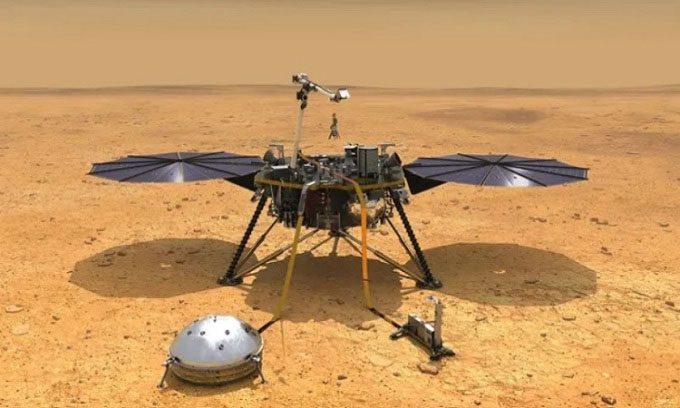The most intense earthquake on the surface of the Red Planet left aftershocks lasting for 6 hours and was detected by NASA’s InSight lander.
The strongest earthquake that shook Mars was not caused by an asteroid impact but by tectonic forces within the planet. A new discovery in research published on October 17 in the journal Geophysical Research Letters indicates that the Red Planet has stronger seismic activity than previously estimated.

Simulation of the InSight lander operating on the surface of Mars. (Photo: NASA)
On May 4, 2022, the InSight lander, which is currently inactive, recorded an earthquake measuring 4.7 on the Richter scale, five times stronger than the previous record of 4.2 measured by InSight in 2021. Unlike most Martian earthquakes that cease within an hour, the aftershocks from this summer’s quake persisted for 6 hours, making it the strongest and longest earthquake ever recorded on another planet.
Since landing in the Elysium Planitia region on Mars in November 2018, InSight has recorded over 1,300 earthquakes, at least 8 of which were caused by asteroid impacts. The signals from the May 2022 earthquake, detected by the highly sensitive seismometer on the lander, resembled those from impacts, prompting scientists to search for a new 300-meter-wide crater and dust plume, both of which would appear immediately after an asteroid impact. Research teams from India, China, Europe, and the United Arab Emirates searched for these signs using their Mars orbiters, but were unsuccessful. This is why, after months of investigation, scientists concluded that the earthquake was tectonic in origin.
Unlike Earth, Mars is too small and too cold to sustain tectonic processes. Earth’s tectonic plates are large, irregularly shaped rock masses with boundaries submerged beneath oceans, moving due to forces in the mantle (the layer between the crust and core), often leading to landslides and earthquakes. However, the surface of Mars does not fracture in the same way as Earth’s, leading researchers to believe that tectonic plates do not exist on the Red Planet. Instead, the earthquakes detected by InSight are likely caused by the release of pressure built up over billions of years within Mars’s crust. This pressure formed and developed as different parts of the planet cooled and contracted at varying rates.
“We still do not fully understand why some parts of the planet seem to have higher pressure than others, but we will investigate further. One day, this information could help us identify safe places for humans to live on Mars and areas to avoid,” said Benjamin Fernando, a postdoctoral researcher at the University of Oxford, England.


















































